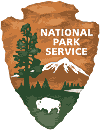Earth Science Week Classroom Activities
Glacier Slide

Activity Source:
Objective
You will be able to describe how a glacier carves an area and label the characteristics formed by the glacier’s movement.
Background
There are many glaciers all over Alaska. Flying into Lake Clark National Park and Preserve through Lake Clark Pass, you will see many glaciers. These glaciers were growing during the last Ice Age. Now many are retreating because Alaska is getting warmer. As the glaciers melt they leave behind evidence of their presence. The evidence includes moraines, erratics, and U-shaped valleys. The weight and movement of glaciers has a changing effect on the landscape. They pick-up rocks, scour out canyons, and push rock debris in front of them as they are growing or flowing. When the glacier is retreating it leaves behind large rocks and boulders known as erratics. It leaves behind a terminal moraine where it stops. Glaciers can create lakes, valleys and areas known as kettle marshes. Their weight and movement are the tools a glacier uses to shape the landscape. Use this experiment to look at small “glaciers” and how they shape the landscape around them.
Materials
Half-gallon milk carton, 12 foot long X 1 foot wide panel or board, sand, rocks, and gravel.
Procedure
- Remove one side panel from the milk carton.
- Fill 1/3 of the milk carton with sand, rocks and gravel mixed with water. Put in freezer.
- When frozen remove from freezer and add another 1/3 sand, gravel and rock mixed with water and freeze.
- When frozen fill final 1/3 with more mix. Freeze until solid.
- On a day when the temperature is above 55ºF and below 80ºF, lay out the board or panel. Set it up at a 20º angle.
- Spread gravel about 1 inch thick on top of the panel.
- Remove frozen block from the milk carton and lay at the top of the panel.
- After approximately 1 hour observe the movement of the block and the carving it created in the gravel.
- In a journal or your Ranger Notebook, write down the types of formations created by the block. Draw a picture to illustrate your observations.
- How is the block like a glacier?
